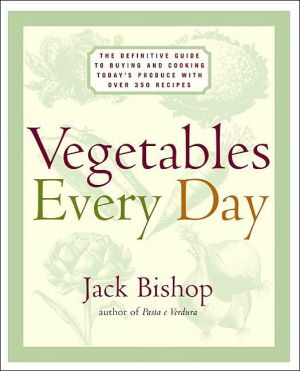Vegetables Every Day: The Definitive Guide to Buying and Cooking Today's Produce, with Over 350 Recipes
The fresh vegetable sections in most supermarkets, farmers' markets, and gourmet groceries are overflowing with an amazing range of produce, both familiar and exotic. Consumers are tempted by kale and kohlrabi, taro and tomatillos, bok choy and burdock, along with all the familiar choices. Now acclaimed cookbook author and food writer Jack Bishop offers a comprehensive A-to-Z guide to this bounty of produce, complete with selection tips, preparation instructions, and hundreds of recipes for...
Search in google:
Vegetable expert Jack Bishop offers a comprehensive, A-Z guide to the amazing range of produce currently available even in local supermarkets. Complete with tips on selecting veggies, preparation instructions, and hundreds of recipes for more than 66 commonly available vegetables, Vegetables Every Day offers temptations on every page. From artichokes to zucchini, jicama to sorrel, each recipe is simple to prepare, and written in the same lively style that made Bishop's previous cookbooks kitchen favorites. Vibrant and original, Vegetables Every Day will make everyone eager to eat their vegetables—every day!About the Author:Jack Bishop is a frequent contributor to the New York Times, a senior writer fro Cook's Illustrated, and the food editor for Natural Health magazine. He lives in Sag Harbor, NY. Publishers Weekly This new cookbook by the author of Pasta e Verdura is for cooks who want to broaden their repertoire of side dishes and capitalize on the abundant produce now available in grocery stores. Not sure how to cook fresh beets? Want your family to try mashed malanga instead of potatoes? Bishop gives helpful instructions on selection, seasonality, cleaning and simple preparation techniques (especially grilling, braising and stir-frying). Readers should know that this is not a vegetarian cookbook offering a breadth of entr es (in fact, beans, except for fava beans, aren't even included), but rather an unadorned volume that offers an exciting twist on foods we know are good for us but often ignore. Simplicity and ease are the hallmarks of this cookbook; however, there are a few idiosyncrasies for the reader to adapt to: the table of contents is alphabetized, but the system is sometimes counterintuitive (squashes are categorized by season--"Winter Squash and Pumpkin" and "Zucchini and Other Summer Squash"--but that's a minor quibble). Many of the salad recipes, such as Moroccan Fennel and Grapefruit Salad with Olives, are inspired, and many ethnic cuisines are represented, though, unfortunately, none in great depth. Cooks who love to read cookbooks will find the streamlined text lacking in historical anecdotes and nutritional information, which would certainly add to the book's health-conscious appeal. Agent, Angela Miller. (Apr.) Forecast: While useful as a guide to selection and basic preparation, this book won't appeal to the many cooks who, pressed for time, look for more comprehensive volumes. However, this title is a natural sell to vegetarians, and enough of them may be interested to produce healthy sales. Copyright 2001 Cahners Business Information.
Chapter One\ Peas\ Sweet green peas come in three distinct forms in our markets. Traditional shelling peas (also called garden peas or English peas) have become something of a rarity. This is the pea we see in the frozen food aisle. Over with the fresh vegetables, they make a brief appearance in late spring and early summer.\ Part of the problem is labor. It takes a long time to shell peas and most people would rather not bother. The other problem is flavor. Shelling peas start to lose their sweet flavor as soon as they are harvested. Peas picked last week will be starchy and mealy. If you want to buy shelling peas, buy from a source that picks them locally and frequently. For these reasons, many cooks stick with frozen peas, knowing they will never be great but that they won't be horrible either. Peas freeze better than most vegetables and are a decent option.\ Thankfully, there are other fresh peas. Two kinds of edible-pod peas are available in many areas throughout the year. Snow peas are pale green and fairly flat. Inside the pods (which are the main attraction with snow peas) are tiny, immature peas, really nothing more than tiny seeds or bumps. We generally stir-fry snow peas, which may explain why some stores label them Chinese peas.\ The other option is the sugar snap pea, which is a cross between the shelling pea and the snow pea. Like snow peas, sugar snap peas are completely edible, pod and all. However, inside the bright green pods are round, little peas that are especially sweet and tender when properly cooked.\ Flat snow peas are best stir-fried without precooking. However, sugar snap peas taste better when blanched firstand then stir-fried or sautéed. Blanching sets the bright green pod color and helps cook the tiny peas inside the pods, which otherwise can be tough if these peas are stir-fried or sautéed without precooking.\ Availability: Snow peas and sugar snap peas are available year-round, although summer is the best season for them. Shelling peas are usually available only in the late spring and early summer.\ Selection: All peas should be brightly colored and crisp. Snow peas will be flexible, while sugar snap and shelling peas should be firm. It's a good idea to taste one or two peas before buying. Peas should be crisp and sweet. If buying shelling peas, open the pod and taste a few. They should be sweet, not starchy or mealy. The peas should fill out the pods, but you don't want swollen peas either; they tend to be starchy.\ Storage: All three kinds of peas can be refrigerated in a loosely sealed plastic bag. Shelling peas start losing flavor as soon as they are picked and are best used immediately. Snow and sugar snap peas will keep for a few days in the refrigerator.\ Basic Preparation: Snow peas are quick to prepare -- simply pull the strings off the ends like a zipper. The same thing holds true for sugar snap peas; sometimes they also have a piece of the stem attached, which needs to be removed.\ As their name suggests, shelling peas must be removed from their pods, a tedious step that yields a very small amount of peas for quite a bit of effort. Grasp hold of the bit of the stem at the end of the pod and pull to open the pods like a zipper. You may need to force the pods open with your fingers by applying pressure on the seam where the string was.\ Best Cooking Methods: Snow peas are best stir-fried. Sugar snap peas should be blanched and then sautéed or stir-fried. Shelling peas are best boiled and but, tered, braised, or used in soups and stews.\ Other Recipes with Peas: Indian Spiced Potatoes and Peas (page 275) Stir-Fried Water Chestnuts and Snow Peas (page 347)\ \ Sugar Snap Peas with Walnuts and Basil\ I find that blanching sugar snap peas before sautéing them guarantees that the peas are cooked through and tender. Shocking the blanched peas prevents them from overcooking and ensures that their exterior remains bright green and does not pucker or shrivel.\ Serves 4 as a side dish\ \ \ Ingredients:\ 1 pound sugar snap peas, stems and strings removed\ Salt\ 2 tablespoons unsalted butter\ 2 tablespoon finely chopped walnuts\ 2 tablespoons finely shredded fresh basil leaves\ Freshly ground black pepper\ \ Instructions:\ \ Bring the water to a boil in a large saucepan. Meanwhile, prepare a bowl of ice water. Add the peas and salt to taste to the boiling water and cook until crisp-tender, about 1 1/2 minutes. Drain and plunge the peas into the bowl of ice water. When cool, drain the peas and set aside.\ Melt the butter in a large skillet. Add the walnuts and cook over medium heat until fragrant, about 2 minutes. Stir in the peas and cook until heated through, about 2 minutes. Stir in the basil and season with salt and pepper to taste. Serve immediately.\ \ Vegetables Every Day. Copyright © by Jack Bishop. Reprinted by permission of HarperCollins Publishers, Inc. All rights reserved. Available now wherever books are sold.
\ From Barnes & NobleThe Barnes & Noble Review\ Ever wonder how to cook those knobby-looking things in the vegetable section? Or what to do with fennel beside cutting it up for crudités? For most of us, the number of vegetables in our local supermarket has definitely exceeded our knowledge and recipe base. Luckily for us, Jack Bishop serves up 350 recipes in his authoritative Vegetables Every Day and shows how to coax the best flavor from every vegetable, from the familiar carrot and potato to the exotic jicama, malanga, salsify, and the knobby celery root. \ In this handsome book, arranged A-Z ("Artichoke" to "Zucchini and Other Summer Squash"), recipes for each vegetable are prefaced with selection and preparation tips. In "Asparagus," for instance, Bishop offers advice on availability, selection, storage, basic preparation, and best cooking methods, followed by recipes for Roasted Asparagus, Grilled Asparagus, Pan-Browned Asparagus with Butter, Stir-Fried Asparagus and Basil with Spicy Orange Sauce, Chinese Egg Noodles with Spicy Asparagus Sauce, Asparagus with Lemon-Mustard Vinaigrette, and Asparagus Fritatta.\ Bishop offers good general advice, too. I've always been impressed by the misting systems in the produce section, but he logically points out that these freshly misted vegetables can rot in your refrigerator if you don't dry them first.\ This is not a vegetarian cookbook, although you'll find plenty of vegetarian dishes. If you're looking for a good salad or side dish, or vegetable soup, or pasta, or rice, you've come to the right book. (Ginger Curwen)\ \ \ \ \ \ Publishers Weekly - Publisher's Weekly\ This new cookbook by the author of Pasta e Verdura is for cooks who want to broaden their repertoire of side dishes and capitalize on the abundant produce now available in grocery stores. Not sure how to cook fresh beets? Want your family to try mashed malanga instead of potatoes? Bishop gives helpful instructions on selection, seasonality, cleaning and simple preparation techniques (especially grilling, braising and stir-frying). Readers should know that this is not a vegetarian cookbook offering a breadth of entr es (in fact, beans, except for fava beans, aren't even included), but rather an unadorned volume that offers an exciting twist on foods we know are good for us but often ignore. Simplicity and ease are the hallmarks of this cookbook; however, there are a few idiosyncrasies for the reader to adapt to: the table of contents is alphabetized, but the system is sometimes counterintuitive (squashes are categorized by season--"Winter Squash and Pumpkin" and "Zucchini and Other Summer Squash"--but that's a minor quibble). Many of the salad recipes, such as Moroccan Fennel and Grapefruit Salad with Olives, are inspired, and many ethnic cuisines are represented, though, unfortunately, none in great depth. Cooks who love to read cookbooks will find the streamlined text lacking in historical anecdotes and nutritional information, which would certainly add to the book's health-conscious appeal. Agent, Angela Miller. (Apr.) Forecast: While useful as a guide to selection and basic preparation, this book won't appeal to the many cooks who, pressed for time, look for more comprehensive volumes. However, this title is a natural sell to vegetarians, and enough of them may be interested to produce healthy sales. Copyright 2001 Cahners Business Information.\ \ \ Library JournalBishop is a senior editor of Cook's Illustrated and author of several other cookbooks celebrating vegetables (Pasta e Verdura). While "definitive" is something of an overstatement, his latest title provides hundreds of recipes and basic information on choosing, storing, and cooking more than 60 vegetables, from the familiar to the still-exotic (calabaza and cardoons, for example). The recipes the majority are side dishes, but there are some main courses, too are quick and simple, just the thing for today's busy cooks. Highly recommended. Copyright 2001 Cahners Business Information.\ \








